A trip to Scotland last weekend to learn the ancient art of Victorian Marmalade Making from marmalade sensei, the Mother in Law. It turned our to be less art and more chemistry! I still don't quite understand how it worked, but it did. Maybe it is actually magic. It was great weather for the project; continuous rain for 3 days.
Step 1. Get Seville oranges, and the same mass of lime and lemons. These kind of oranges are mostly pith and pips, taste very bitter, and can only be found in January, although not only in Scotland. Wash and remove the ends, and any nasty ones.
Step 2. Juice fruits! An acceptable diversion from Victorian tradition is to use an electric juicer. The juice goes into the juice pot, the pith and pips into the pith and pits pot, and the shells of rind go to the slicer. The slicer is a large heavy metal thing that clamps to the table, a handle is turned and sliced peel comes out of the bottom. A non-Victorian alternative to the slicer is unknown.
 |
 |
Step 3. Add water to the pith and pips bowl and to the rind. pints of water = 1.1 x weight of fruit in lbs, with about 0.1 going into the pith.
Step 4. Soaking the fruit is neither here not there as far as the chemistry/magic is concerned, apparently. But by now you will be tired, so you can take a break ... overnight if you like.
 |
| Don't forget your cat! |
Step 5. Find cauldron! Put rind-marinade into cauldron.
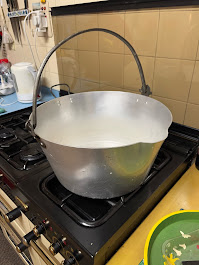
Step 6. Manufacture a bag from cloth and string that contains the pith and pips, and suspend in cauldron. This bag contains the magical carbohydrate pectin which is required to make the marmalade set. Bring to boil and cook for an hour (the internet suggests 2-3 hours for bright, tender marmalade. The internet might be wrong.). Apparently the acid from the fruit helps get the pectin out, but I don't understand this, becuase the juice is not yet added at this stage.

Step 7. Turn off the heat. Extract bag from cauldron and squeeze it hard to get out all the pectin.
Steps 11-13. Add yet more sugar. About 1.6x weight of fruit in total!!!!
Step 14. Bring slowly to a rolling boil.

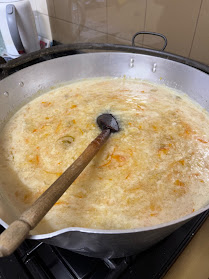
Step 15. Excitedly test every 5 seconds to see if it is done yet. It is done when it sets. This is the magic/chemistry bit. Pectin and acid and heated up sugar and do something or other that makes - jelly. But this isn't the same as caramalisation that you use to make toffee, which is more like burning sugar. In fact you want as little caramalisation as possible, because marmalade shouldn't taste like toffee. This is why the internet says boil for 15-20mins. The internet also says too much boiling at this stage make the rind tough. It was more like an hour for us, but our marmalade is still pretty and the rind very nice. Maybe internet people want the rind to melt in their mouths or something weird?
Anyway, you can test by cooling a small spoonful on a plate and when it starts to set it is done, or use a Victorian thermometer. Not sure what the markings on the thermometer engraved by ancestors mean, but when the brass holder gets all sticky with globs of marmalade, it is done.
Step 16. Remove from heat and quickly fill up all your jars (which, hopefully, appear beside you by magic) and screw the lids on ASAP.
Optional Step. Next day, if some of your jars are not screw top, or they are screw top but the button on the lid didn't go down as the marmalade cooled, or you don't have lids... melt paraffin wax (in a jug in boiling water) and pour over the top and slap on some kind of lid! Marmalade will stay good for ... 3 years or so?
Step 17. Eat. Yum yum!




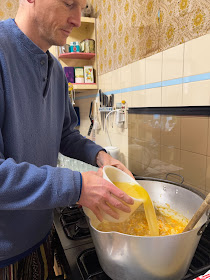




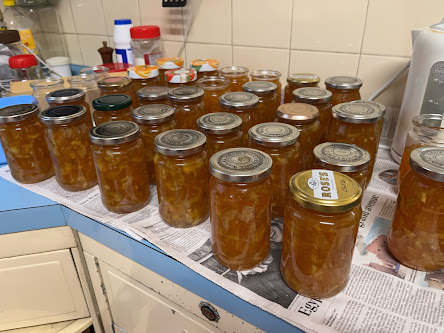


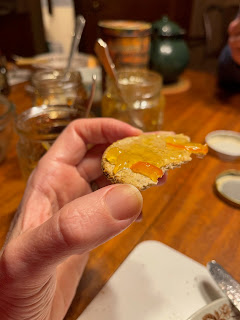
1 comment:
Seville oranges are the laughingstock of the Spanish Navy.
Seek out the Moro blood orange cultivar.
Use it ripe but mold-free, and you will have something that
tastes amazing and out ages Oxford Vintage.
Post a Comment